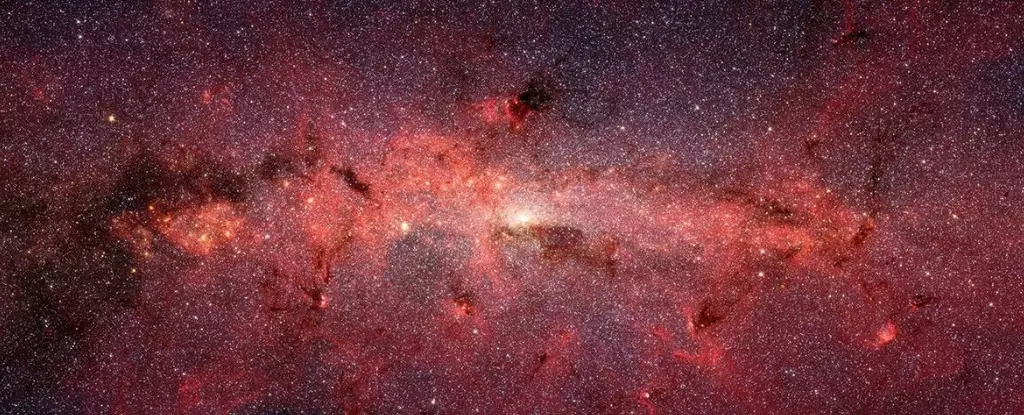As human beings, our relentless pursuit of knowledge often leads us to the enigmatic depths of our universe. At the heart of such inquiry lies a paradox: dark matter. Comprising approximately 85% of the universe’s mass, this elusive entity remains invisible, detectable only through its gravitational influence. Yet, recent investigations into two peculiar phenomena within the passionate embrace of our Milky Way’s core compel us to reconsider our understanding of cosmic forces. These phenomena—the heightened ionization of gas in the central molecular zone (CMZ) and the mysterious emission of gamma rays at 511 keV—highlight the importance of pushing the boundaries of our astrophysical comprehension.
The Chaotic Core of Our Galaxy
Situated nearly 26,000 light-years away, the CMZ is a tumultuous region characterized by a dense concentration of molecular gas and intricate stellar processes. Remarkably, astronomers have noted an accelerated rate of ionization within this chaotic region, as hydrogen molecules encounter enough energy to shed their electrons. On the surface, this could be attributed to cosmic rays or starlight, yet these traditional explanations fail to resonate with the intensity of ionization observed in the CMZ. Is there something deeper at work, something innovative that stretches beyond conventional interpretations? This question becomes especially pivotal as the quest intersects with the gamma ray anomaly that has haunted astrophysicists since the 1970s.
The Gamma Ray Puzzle
Imagine an elegant dance of electrons and their antithesis, positrons, culminating in a spectacular flash of gamma rays. This is precisely what should occur when these particles collide, yet the source of the 511 keV emissions has remained a vexing enigma. Proposals ranging from black holes to supernovae have been thrust into the spotlight, each failing to account for the peculiar characteristics of the gamma glow. Instead of wedging these phenomena into existing frameworks, it’s imperative that we entertain the proposition that dark matter could be the architect behind both the CMZ’s heightened ionization and the elusive gamma rays.
Revealing Subtle Links
Recent studies have shed light on a potentially groundbreaking hypothesis: the interactions of light dark matter particles could be igniting these cosmic phenomena. Imagine a scenario where sub-GeV dark matter particles annihilate upon contact with their antiparticles at the galactic center, creating a cascade of electrons and positrons. This reaction possesses the uncanny ability to generate the kind of ionization observed through sophisticated simulations, where energy is deposited locally due to the dense environment of the CMZ. Could it be that the ordinary interactions of invisible particles are at the very core of extraordinary cosmic mysteries?
Such a synthesis opens a tantalizing avenue of exploration—one that bridges the gap between general astrophysical behavior and particle physics. This notion proposes that the same annihilation events giving rise to positrons may also yield gamma rays, effectively merging what have long been seen as separate cosmic conundrums.
Revisiting Dark Matter’s Dynamic Nature
These revelations usher in a renewed vigor in the investigation of dark matter’s properties. Questions once regarded as esoteric—such as the mass of dark matter particles and their modes of interaction—are now thrust into the limelight. The implications suggest that light dark matter candidates may function as both the architects and agents of the observable universe’s dynamics. This exciting concept not only redefines our understanding of dark matter, but it also allows us to derive new principles through the CMZ’s intriguing characteristics.
What if the gamma rays that light our skies are, in fact, subtle heralds of a larger, unifying theory? The interconnectedness of ionization and 511 keV emissions paints a compelling picture in which the Milky Way’s center serves as a laboratory for truths yet to be unveiled. Observations from future, highly advanced telescopes might elucidate these cosmic relationships and further illuminate the intricate dance of dark matter in shaping our universe.
Beyond the Edge of Comprehension
As we scrutinize the CMZ and its peculiar offerings, we stand on the precipice of discovery. The universe remains a vast tapestry woven with extraordinary complexities, where even the most scintillating discoveries invite more questions than answers. By delving into the mysteries surrounding dark matter and its presumed role in the behaviors of particles, we inch closer to grasping the cosmic narrative.
This quest reiterates a sentiment that must resonate with progressive thinking: to remain curious, to challenge established paradigms, and ultimately, to embark on wild hypotheses. The persistence of anomalies in the galactic center compels us to look not only to the far reaches of space for answers but also inward, toward our very existence amid the stars. The heart of the Milky Way remains an ever-evolving narrative—a beacon that entices us to question, explore, and embrace the wondrous ambiguity of our universe.

Leave a Reply